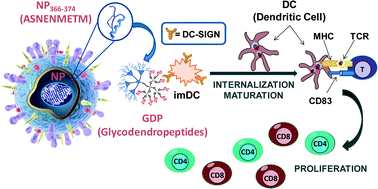Glycodendropeptides stimulate dendritic cell maturation and T cell proliferation: a potential influenza A virus immunotherapy†
Abstract
Mannosylation facilitates uptake and internalization of immunogenic peptides by antigen-processing cells expressing mannose receptors at their surface, such as DC-SIGN, a lectin that plays a key role in the immune response against different pathogens. This internalization, processing and subsequent MHC presentation may result in a strong T cell stimulation. Here, we hypothesized that combining mannose glycodendrons with multivalent presentation of peptide epitopes in a likewise dendron format would yield hybrid constructs, named glycodendropeptides (GDPs), with the capacity to enhance peptide immunogenicity, hence providing a novel and versatile platform for applications in immunotherapy. Thus, GDPs of different valencies displaying the NP366–374 epitope, a conserved sequence from the influenza A virus nucleoprotein (NP), have been built by two click chemistry-based methodologies and assessed as potential flu vaccine candidates. Preliminary evaluation of the ability of these constructs to stimulate dendritic cell maturation and lymphocyte proliferation was promising, showing the highest-functionalized NP366–374 GDPs as inducing the strongest immunostimulatory effect.


 Please wait while we load your content...
Please wait while we load your content...